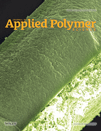Preparation and characterization of cyhalothrin-loaded poly(2-hydroxyethyl methacrylate)-co-polylactide (PHEMA-co-PLA) ultrafine particles
Abstract
Poly(2-hydroxyethyl methacrylate)-co-polylactide (PHEMA-co-PLA) and its corresponding cyhalothrin-loaded ultrafine particles were successfully synthesized and prepared, respectively. The chemical structures of the copolymers have been confirmed by Fourier transform infrared spectroscopy (FTIR), 1H-nuclear magnetic resonance (1H-NMR), 13C-nuclear magnetic resonance (13C-NMR), and thermogravimetric analysis (TGA). Furthermore, the particle size, the cyhalothrin loading content (LC), and the cyhalothrin release behavior were investigated. PHEMA-co-PLA proved to be a good material for the preparation of ultrafine particles for lipophilic pesticide delivery. The developed cyhalothrin-loaded PHEMA-co-PLA ultrafine particles showed good dispersity in water and sustained release behavior. In addition, it is easy to be prepared by both nanoprecipitation method and emulsion/solvent evaporation method. © 2012 Wiley Periodicals, Inc. J. Appl. Polym. Sci., 2013




